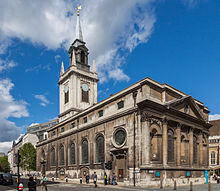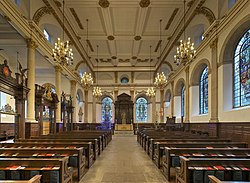St Lawrence Jewry
| St Lawrence Jewry | |
|---|---|
 St Lawrence Jewry from the south-east | |
 | |
| Location | London, EC2 |
| Country | United Kingdom |
| Denomination | Church of England |
| Previous denomination | Roman Catholicism |
| History | |
| Dedication | St Lawrence |
| Architecture | |
| Heritage designation | Grade I listed building |
| Architect(s) | Christopher Wren |
| Style | Baroque |
| Administration | |
| Diocese | London |

St Lawrence Jewry next Guildhall is a Church of England guild church in the City of London on Gresham Street, next to the Guildhall. It was destroyed in the Great Fire of London in 1666, and rebuilt to the designs of Sir Christopher Wren. It is the official church of the Lord Mayor of London.
History
Medieval era
The church was originally built in the twelfth century and dedicated to St Lawrence; the weather vane of the present church is in the form of his instrument of martyrdom, the gridiron.[1] The church is near the former medieval Jewish ghetto,[2] which was centred on the street named Old Jewry.[3] From 1280 it was within the advowson of Balliol College, Oxford.
Sir Thomas More preached in the old church on this site.[4]
17th century
In 1618 the church was repaired, and all the windows filled with stained glass paid for by individual donors.[5]
The medieval church was destroyed in the Great Fire of London[6] and rebuilt by Christopher Wren between 1670 and 1687.[7] The parish was united with that of St Mary Magdalen, Milk Street, which was not rebuilt.[5] The church is entirely faced in stone, with a grand east front, on which four attached Corinthian columns, raised on a basement, support a pediment placed against a high attic.[7] George Godwin, writing in 1839, described the details of this facade as displaying " a purity of feeling almost Grecian", while pointing out that Wren's pediment acts only as a superficial adornment to the wall, rather than, as in Classical architecture, forming an extension of the roof.[5]
Inside, Wren's church has an aisle on the north side only, divided from the nave by Corinthian columns, carrying an entablature that continues around the walls of the main body of the church, where it is supported on pilasters. The ceiling is divided into sunken panels, ornamented with wreaths and branches.[5] The church is 81 feet long and 68 feet wide.[8]

20th century
The church suffered extensive damage during the Blitz on 29 December 1940,[9] and after the war the City of London Corporation agreed to restore it as Balliol College had no funds to do so. It was restored in 1957 by Cecil Brown to Wren's original design. It is no longer a parish church, but a guild church, the advowson transferred to the City as its official church.
The church was described by Sir John Betjeman as "very municipal, very splendid."[10] It was designated a Grade I listed building on 4 January 1950.[11][12]
The church was the burial place of John Tillotson, archbishop of Canterbury;[13] and of merchant Francis Levett, as well as the site of the wedding of his niece Ann Levett, daughter of William Levett, Dean of Bristol and former Principal of Magdalen Hall, Oxford .[14]
The church is used by the New Zealand Society UK, who celebrate Waitangi Day here in February each year.[15]
Vicars (incomplete list)
- 1566–1570 William Palmer[16]
- 1578–81 Samuel Perkins[17]
- 1650–1656 Richard Vines was minister[18]
- 1661–1662 Seth Ward[19]
- 1662–1668 John Wilkins[20]
- 1668–1683 Benjamin Whichcote[21]
- 1686–1721 John Mapletoft[22]
- 1898–1920 James Stephen Barrass[23]
- 2007–Present The Reverend Canon David Parrott[24]
See also
- St Lawrence and Mary Magdalene Drinking Fountain
- List of churches and cathedrals of London
- List of Christopher Wren churches in London
Notes
- ^ Bradley, Simon & Pevsner, Nikolaus. "London: the City Churches". New Haven: Yale University Press, 2002 ISBN 0-300-09655-0
- ^ Hibbert, C; Weinreb, D.; Keay, J. "The London Encyclopaedia". London: Pan Macmillan, 1983 (rev 1993, 2008) ISBN 978-1-4050-4924-5
- ^ Tucker, T. "The Visitors Guide to the City of London Churches". London: Friends of the City Churches, 2006 ISBN 0-9553945-0-3
- ^ "St Lawrence Jewry". London Taxi Tour. Archived from the original on 12 May 2008. Retrieved 11 April 2009.
- ^ a b c d Godwin, George; John Britton (1839). The Churches of London: A History and Description of the Ecclesiastical Edifices of the Metropolis. London: C. Tilt. Retrieved 8 October 2011.
- ^ "The City Churches" Tabor, M. p76:London; The Swarthmore Press Ltd; 1917
- ^ a b Bradley, Simon; Pevsner, Nikolaus (1998). London: the City Churches. The Buildings of England. London: Penguin Books. pp. 995–6. ISBN 0-14-071100-7.
- ^ Elmes, James (1831). A Topographical Dictionary of London and its Environs. London: Whittaker, Treacher and Arnot. p. 303. Retrieved 24 September 2011.
- ^ Cobb, G. "The Old Churches of London". London: Batsford, 1942
- ^ Betjeman, J. "The City of London Churches". Andover: Pikin, 1967 ISBN 0-85372-112-2
- ^ Historic England. "Details from listed building database (1064673)". National Heritage List for England. Retrieved 23 January 2009.
- ^ Historic England, "Church of St Lawrence Jewry (1064673)", National Heritage List for England, retrieved 23 July 2017
- ^ Elmes, James (1831). A Topographical Dictionary of London and its Environs. London: Whittaker, Treacher and Arnot. p. 263.
- ^ Publications of the Harleian Society, Vol. XXVI, London, 1887
- ^ "St Lawrence Jewry February 2016 Newsletter" (PDF). Company of Distillers. February 2016. Archived from the original (PDF) on 15 February 2016. Retrieved 9 February 2016.
- ^ "Palmer, Stephen (PLMR555W)". A Cambridge Alumni Database. University of Cambridge.
- ^ "Parkens, Samuel (PRKS567S)". A Cambridge Alumni Database. University of Cambridge.
- ^ "Vines, Richard (VNS619R)". A Cambridge Alumni Database. University of Cambridge.
- ^ "Ward, Seth (WRT632S)". A Cambridge Alumni Database. University of Cambridge.
- ^ "Wilkins, John (WLKS639J)". A Cambridge Alumni Database. University of Cambridge.
- ^ "Whichcote, Benjamin (WHCT626B)". A Cambridge Alumni Database. University of Cambridge.
- ^ "Mapletoft, John (MPLT648J)". A Cambridge Alumni Database. University of Cambridge.
- ^ "Barrass, James Stephen (BRS884JS)". A Cambridge Alumni Database. University of Cambridge.
- ^ http://constructorscompany.org.uk/index.php?page=canon-david-parrot
External links
- Use dmy dates from June 2013
- Rebuilt churches in the United Kingdom
- Christopher Wren church buildings in London
- Church of England church buildings in the City of London
- Religious buildings and structures completed in 1687
- 17th-century Church of England church buildings
- Religious organizations established in the 12th century
- English Baroque architecture
- Churches bombed by the Luftwaffe in London
- Grade I listed churches in the City of London
- Diocese of London
